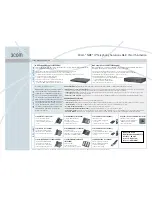
Preparation
15
the base unit or charger without any ill
effect on the batteries.
L
The battery level may not be
displayed correctly after you replace
the batteries. In this case, place the
handset on the base unit or charger
and let it charge for at least 7 hours.
Symbols used in these
operating instructions
Setting up the unit
before use
Date and time
1
{
MENU
}
i
{#}{
1
}{
0
}{
1
}
2
Enter the current date, month, and
year by selecting 2 digits for each.
Example:
15 July, 2008
{
1
}{
5
}
{
0
}{
7
}
{
0
}{
8
}
3
Enter the current hour and minute
(12-hour clock format) by selecting 2
digits for each.
Example:
9:30
{
0
}{
9
}
{
3
}{
0
}
4
{
AM/PM
}
: Select
“
AM
”
or
“
PM
”
.
5
{
Save
}
i
{
OFF
}
Note:
L
To correct a digit, press
{^}
,
{V}
,
{
<
}
,
or
{
>
}
to move the cursor to the digit,
then make the correction.
L
The date and time may be incorrect
after a power failure. In this case, set
the date and time again.
Headset (optional)
Connecting a headset to the handset
allows for hands-free conversations.
Note:
L
Only telecommunications compliance
labelled headset should be plugged
into the headset socket on the
handset.
Switching a call between the headset
and handset speakerphone
To switch to the handset speakerphone,
press
{s}
.
To return to the headset, press
{C}
.
Symbol
Meaning
{ }
The words in the
brackets indicate
button names/soft key
names on the handset
and base unit.
Example:
Unit keys:
{C}
,
{
OFF
}
Soft keys:
{
View CID
}
,
{
Phonebook
}
i
Proceed to the next
operation.
“ ”
The words in
quotations indicate the
menu on the display.
Example: “
Alarm
”
{V}
/
{^}
:
“ ”
Press
{V}
or
{^}
to
select the words in
quotations.
Example:
{V}
/
{^}
:
“
Off
”
TG43xxAL(e)_OI.book Page 15 Friday, May 23, 2008 3:51 PM
















































